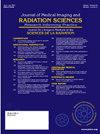The volumetric and dosimetric impacts of respiratory motion management in lung SBRT: A systematic review from 2019-2024
IF 1.3
Q3 RADIOLOGY, NUCLEAR MEDICINE & MEDICAL IMAGING
Journal of Medical Imaging and Radiation Sciences
Pub Date : 2025-02-15
DOI:10.1016/j.jmir.2025.101860
引用次数: 0
Abstract
Background
The efficacy of Stereotactic Body Radiation Therapy (SBRT) is contingent upon accurately accounting for respiratory motion. Although several methods have been developed, the extent of volumetric and dosimetric benefit, as well as the criteria for selecting appropriate methods for individual patients remain unclear.
Purpose
To assess the extent of target volume reduction and lung dose reduction in lung cancer patients treated with SBRT, comparing active versus non-active respiratory motion management approaches.
Materials and Methods
A comprehensive search was conducted across multiple databases, including MEDLINE Ovid (PubMed), EMBASE, and the Web of Science Core Collection, covering the period from 2019 to 2024. The Preferred Reporting Items for Systematic Reviews and Meta-Analyses (PRISMA) guidelines were followed to identify studies relevant to respiratory motion management in lung SBRT. Data extracted included target volume delineation, target volume sizes, and lung doses reported.
Results
The review included 14 studies involving 273 patients, which examined both active and non-active respiratory motion management approaches. Active respiratory motion management approaches were associated with significant reduced target volume sizes and lung doses compared to non-active approaches. Tracking and deep inspiration breath-hold demonstrated superiority in reduction in target volume and lung protection, with tracking showing the greatest reduction in target volume.
Conclusion
Patient selection is crucial when determining the most appropriate respiratory motion management approach. Establishing a consensus on planning objective is necessary for accurate data evaluation. Further research is required to refine these techniques and explore innovative technologies that could enhance the effectiveness and safety of respiratory motion management in lung SBRT.
求助全文
约1分钟内获得全文
求助全文
来源期刊

Journal of Medical Imaging and Radiation Sciences
RADIOLOGY, NUCLEAR MEDICINE & MEDICAL IMAGING-
CiteScore
2.30
自引率
11.10%
发文量
231
审稿时长
53 days
期刊介绍:
Journal of Medical Imaging and Radiation Sciences is the official peer-reviewed journal of the Canadian Association of Medical Radiation Technologists. This journal is published four times a year and is circulated to approximately 11,000 medical radiation technologists, libraries and radiology departments throughout Canada, the United States and overseas. The Journal publishes articles on recent research, new technology and techniques, professional practices, technologists viewpoints as well as relevant book reviews.
 求助内容:
求助内容: 应助结果提醒方式:
应助结果提醒方式:


